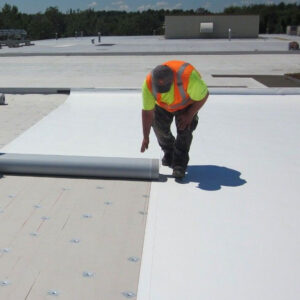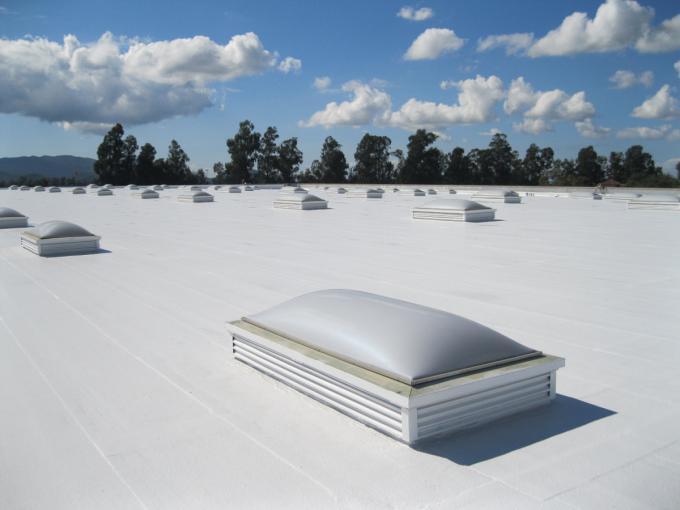Flat or Low-slope roofs? 5 Common Roofing Membrane Types That Are Great Options
A leaking commercial roof, a roof that experiences ponding water, or a roof that has poor energy efficiency can be problematic, especially in a commercial building. They constitute a hazard to workers, support mold and bug infestation, and also make you spend more money on energy.
To avoid such a situation, you find many building owners across the U.S, especially those in the mid-Atlantic region, installing membrane roofing systems such as PVC, TPO, BUR, MB, and EPDM.
Although there are more membrane types available, we will discuss these five because we consider them to be the best, and we also carry out roof installations using these membranes.
Let’s begin by explaining what the membranes are and breaking down the acronyms.
Definition of a Membrane Roof
 A membrane roof is a waterproof material that makes your roofing system waterproof resistant. It can be flexible or semi-flexible, and it can also be made from single or multiple materials joined together.
A membrane roof is a waterproof material that makes your roofing system waterproof resistant. It can be flexible or semi-flexible, and it can also be made from single or multiple materials joined together.
Membrane materials are primarily designed for industrial and commercial buildings that have low or flat-slope roofs, although they can also be used on residential buildings.
Although low and flat-slope roofs do have a little pitch that supports water drainage, it doesn’t do as much as they should. Unlike roofs with steeper pitches that support the easy flow of melting snow and rainwater, flat slopes don’t have such an easy flow. Hence, it is important for owners of buildings with flat- or low-slope roofs to choose the best membranes for water protection.
5 Different Types of Commercial Roofing Membranes
Just as we listed earlier, the 5 types of roofing membranes we recommend and will be discussing here include:
- Built-up Roofing [BUR]
- Ethylene Propylene Diene Monomer [EPDM]
- Modified Bitumen [MB]
- Polyvinyl Chloride [PVC]
- Thermoplastic Polyolefin [TPO]
Let’s explore the features of each membrane, as well as their strong points and what makes one better than the other. It is important to mention that the preference of one membrane over the other will largely depend on the nature of your roof and your usage needs.
1. Built-up Roofing [BUR] Membrane
The BUR membrane has been around for a long time and is still being used today.
Fabric layers or plies are built-up in an overlapping format on the roof and then infused with bitumen. The fabric layers are used alternatively with asphalt-based materials such as bitumen/tar and then coated with aggregate.
Several newer versions of BUR roofs have more materials added to improve their strength and they are sometimes referred to as modified bitumen membranes.
Here are some advantages of BUR membrane:
- Long years of trust
- High fire resistance
- Great durability
- Lifespan of 25 years and above with the right maintenance
- Waterproof
2. Ethylene Propylene Diene Monomer [EPDM]
An EPDM membrane is another common membrane type. It is a type of single-ply membrane roofing that resembles an inner tube on a roof that is stretched out, hence the nickname rubber roof membrane.
EPDM is applicable to ballasted, fully-adhered, or loose-laid roofing systems.
When being used for fully-adhered systems, the EPDM membrane is first coated in adhesive before it is rolled into place and then smoothed into place. For loose-laid and ballasted roofing systems, the EPDM membrane is loose-laid upon the roof.
Here are some advantages of the EPDM membrane:
- Lifespan of 30 years or longer with adequate maintenance
- Highly durable
- Waterproof
- Resistant to fatigue, wear and impact
3. Modified Bitumen [MB]
Modified Bitumen or Mod Bit is similar to BUR because it is constructed in layers. However, MB roofing membranes are sometimes called rubber roofing because they have a rubberlike appearance and properties because petroleum-based substances are placed in between the plies to hold them together.
Here are some advantages of MB roofing membrane
- Easy installation without heat
- Withstands foot traffic
- Extremely durable
- Energy saving due to reflective material
4. Polyvinyl Chloride [PVC]
PVC roofing membrane is classified as a thermoplastic material because it reacts based on temperature. That is, it becomes rigid when cold and softens when heated.
PVC membranes are often placed on the roof in overlapping sheets and then the seams are welded with hot air to ensure a firm and watertight seal. However, the nature of your commercial building’s roofing system will determine whether it is enforced this way or some other way.
PCV roofing membranes are highly resistant to grease, chemicals, and fire, making them great for restaurants and facilities that engage in food production.
Advantages of PVC roofing membranes include:
- Energy efficiency
- Lifespan of 25 years or longer with adequate maintenance
- UV and Heat resistant
- Recyclable
5. Thermoplastic Polyolefin [TPO]
TPO is also a thermoplastic material like PVC, so you will often find both membranes grouped together. TPO is relatively new in the market and is great for commercial buildings.
If you are dealing with a mechanically-fastened roofing system, TPO is adhered to the roof using fasteners and plates. For a fully-adhered system, the TPO is adhered to using an adhesive.
Advantages of TPO membranes:
- Energy efficiency
- Available in multiple colors
- Durable against weather and temperature changes
- Lifespan of 30 years and above with proper maintenance.
- Cost Efficiency
Which Roof Membrane is best for your building?
There are so many factors involved in deciding what roof membrane is best for your San Diego commercial building. You’ll need to consider the pitch of your roof, the existing roofing system, and material, the condition of your roof, as well as the nature of the job being done in the building.
To handle all possible considerations and decide on the best roof membrane, you are advised to contact an experienced roofing company near you to offer professional insight.
With over 60 years of handling commercial roofing installations, repairs, and consultations, we have what it takes to handle your commercial roofing jobs. We know the best membranes and processes to use on your roof depending on the nature of your building. We will handle all considerations and concerns, and ensure that you get only the best material and installation for your roof.
Reach out to us today to get a roofing estimate from our team of experts who are waiting to help you.
